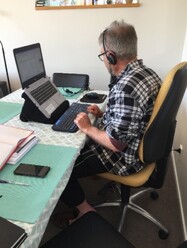How to set up your Home Computer Workstation
Here are some practical instructions and tips to set up your home computer workstation with a supported posture to avoid aches and pains.
Home Computer Workstation Furniture
The aim is to set up your computer workstation so that you have a relaxed and comfortable posture. There are no set rules, but key items to consider are:
- Desk/working surface: The ideal computer workstation desk is around 700mm high but if you are substituting with another surface such as a dining room table, try to ensure it is a flat work surface with adequate space for computer equipment and documents etc. Avoid clutter on or under your desk!
- Chair: Ideally a computer workstation office chair is best to provide flexibility and postural support, but if not available make sure your chair seat is high enough to type with relaxed shoulders.
Hot tip: if you don’t have a height adjustable chair seat you may need to use cushions to raise yourself, so forearms are above your keyboard.
Your feet should easily reach the floor, with hips, knees and ankle at right angles.
Hot tip: Use books or a carton for a footrest if your feet don’t easily reach the floor.
- Standing workstations: Posture advice is the same as sitting. Ease into standing: regular changes from sitting to standing and vice versa are recommended Hot Tip: Using the kitchen bench can be a good way to improvise a standing workstation
Home Workstation Computer Equipment set up:
Hot Tip: Try to set yourself up with a separate screen, keyboard and mouse rather than using a laptop all the time, as this will allow a more comfortable working posture.
- Screen: Top of screen at eye level. The natural line of sight is below eye level. Hot Tip: If using laptop with a separate keyboard, place the laptop on a pile of books to correct screen height.
- Keyboard: Separate keyboard is best. Using a laptop keyboard all the time constrains the neck and arm postures.
- Mouse: Separate mouse is best (see above). Wireless mouse is more adaptable.
- Phone: Avoid prolonged periods of time holding a phone. Use a headset or speaker phone (if you are in a private area) if you are making a lot of calls, or if you’re using online meetings or calls
Check Your Computer Posture:
Neck should be upright and aligned. Avoid poking chin and slumped lower or upper back. Hands should be relaxed over the keyboard with elbows about 90 degrees (right angles). Shoulder and neck muscles should be relaxed.
Breaks:
Regular changes of posture and position. are important. Don’t sit for more than 30 minutes at a time. Take regular short breaks away from the workstation. Change your focal distance by looking outside periodically.
Hot Tip: moving as much as possible, particularly changing positions is the most important tip for computer work.
Stretch and Move:
Walk frequently, around your house, section, or the block (in your bubble). Stretches reduce tension in frequently used muscles in your arms and trunk. Reverse your posture! Stretch in the opposite direction to the position you are working in. Check out the following link for office stretches on the ACC website: https://www.acc.co.nz/assets/i...
Social:
Maintain regular contact with friends and work colleagues. Try to stay in your usual work routine. Get dressed before starting work! Set goals and tasks for your workday.
Refer to www.habitatwork.co.nz for further information about office workstations.

